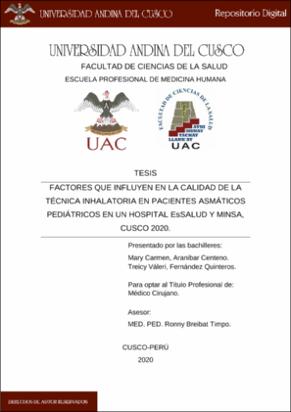| dc.contributor.advisor | Breibat Timpo, Ronny | |
| dc.contributor.author | Aranibar Centeno, Mary Carmen | |
| dc.contributor.author | Fernández Quinteros, Treicy Váleri | |
| dc.date.accessioned | 2020-09-15T21:41:56Z | |
| dc.date.available | 2020-09-15T21:41:56Z | |
| dc.date.issued | 2020-05-13 | |
| dc.identifier.uri | https://hdl.handle.net/20.500.12557/3394 | |
| dc.description.abstract | Antecedentes: Existen factores que influyen en la técnica inhalatoria, como los
relacionados al paciente y al cuidador. En Perú se calcula que uno de cada cinco niños
tiene asma. El objetivo de esta investigación es determinar los factores que influyen en
calidad de la Técnica Inhalatoria en Pacientes Asmáticos Pediátricos.
Metodología: Se trata de un estudio cuantitativo de diseño no experimental, de corte
transversal, descriptivo y observacional, el tipo de muestreo fue aleatoria probabilística.
La muestra estuvo conformada por 106 cuidadores de niños asmáticos de 2 a 14 años.
Resultados: En este estudio se encontró que con mayor frecuencia los cuidadores
entrevistados realizaron una mala calidad de técnica inhalatoria (55.7%) y el número de
respiraciones por boca es el paso de mayor error. Los factores que influyen en la calidad
de la técnica inhalatoria fueron: la edad (p=0.024) mostrando que los niños ≥ 9 años
tiene una buena técnica inhalatoria, la reacción de niño durante el procedimiento
(p=0.000) y el tiempo de uso el inhalador (p=0.044). Los cuidadores de 31 y 50 años
realizaron una buena técnica (p=0.018); además que, a mayor grado de instrucción y
mejor nivel socioeconómico, los cuidadores realizan una buena calidad de técnica
inhalatoria (p=0.000 respectivamente). Los entrevistados que fueron instruidos por un
pediatra realizan una buena técnica inhalatoria 55.9% (p=0.042), y los cuidadores que
fueron instruidos en un consultorio particular (78.3%) presentaron con mayor frecuencia
una mejor técnica inhalatoria (p=0.000).
Conclusión: La técnica inhalatoria en pacientes asmáticos pediátricos es de mala
calidad, los factores que influyen en la calidad de la técnica son: la edad, la reacción de
niño durante el procedimiento y el tiempo que usa el inhalador; la edad, el grado de
instrucción y nivel socioeconómico del cuidador; finalmente la persona y el lugar donde
se instruye la técnica. | es_PE |
| dc.description.abstract | Antecedents: There are factors that influence the inhalation technique, such as those
related to the patient and the caregiver. In Peru, it is estimated that one in five children
has asthma. The objective of this research is to determine the factors that influence the
quality of the Inhalation Technique in Pediatric Asthmatic Patients.
Methods: It is a quantitative study of non-experimental design, cross-sectional,
descriptive and observational, the type of sampling was random probability. The sample
consisted of 106 caregivers of asthmatic children from 2 to 14 years old.
Results: In this study, it was found that the caregivers interviewed performed a poor
quality of inhalation technique more frequently (55.7%) and the number of breaths per
mouth was the step with the greatest error. The factors that influence the quality of the
inhalation technique were: age (p=0.024) showing that children ≥ 9 years old have a
good inhalation technique, the child's reaction during the procedure (p=0.000) and the
time of use the inhaler (p=0.044). The caregivers of 31 and 50 years old performed a
good technique (p = 0.018); Furthermore, the higher the level of education and the better
the socioeconomic level, the caregivers perform a good quality inhalation technique
(p=0.000, respectively). Respondents who were instructed by a pediatrician performed a
good inhalation technique 55.9% (p = 0.042), and caregivers who were instructed in a
private practice (78.3%) presented a better inhalation technique more frequently
(p=0.000).
Conclusion: The inhalation technique in pediatric asthmatic patients is of poor quality.
The factors that influence the quality of the technique are age, the child's reaction during
the procedure and the time that the inhaler is used; the caregiver's age, educational level
and socioeconomic level; finally, the person and place where the technique is taught. | en_US |
| dc.description.uri | Tesis | es_PE |
| dc.format | application/pdf | es_PE |
| dc.language.iso | spa | es_PE |
| dc.publisher | Universidad Andina del Cusco | es_PE |
| dc.rights | info:eu-repo/semantics/openAccess | es_PE |
| dc.rights.uri | https://creativecommons.org/licenses/by-nc-nd/2.5/pe/ | es_PE |
| dc.source | Universidad Andina del Cusco | es_PE |
| dc.source | Repositorio Institucional UAC | es_PE |
| dc.subject | Técnica inhalatoria | es_PE |
| dc.subject | Asma | es_PE |
| dc.subject | Inhalador de dosis medida | es_PE |
| dc.title | Factores que influyen en la calidad de la técnica inhalatoria en pacientes asmáticos pediátricos en un Hospital Essalud y MINSA, Cusco 2020 | es_PE |
| dc.type | info:eu-repo/semantics/bachelorThesis | es_PE |
| thesis.degree.name | Médico Cirujano | es_PE |
| thesis.degree.grantor | Universidad Andina del Cusco. Facultad de Ciencias de la Salud | es_PE |
| thesis.degree.level | Titulo Profesional | es_PE |
| thesis.degree.discipline | Medicina Humana | es_PE |


